WOMENS CLOTHING
As the weather swings between the seasons, your choice of cycle clothing becomes all the more important. A single layer, or the length of your trousers can make the difference between a pleasant jaunt through the beautiful countryside to an exhausting slog through the bleakest landscape.
But remember, you don't necessarily need to dress yourself up like a pro to receive all the benefits that cycling offers. Having 'all the gear and no idea' can be just as counter-productive as having the right idea but rubbish gear. Fortunately, modern women's cycle clothing is designed to be functional and fashionable in equal measure.
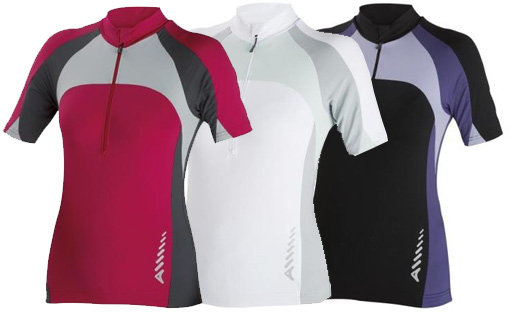 Women's Cycle Wear - Tops
Women's Cycle Wear - Tops
Brands like Fox, Assos, Linebreak and Northwave have all invested heavily in researching and developing the most cutting-edge fabrics and materials that will keep you cool when it's hot, warm when it's not, and looking good all year round. Women's cycling tops come in a few varieties: long sleeve tops, short-sleeve tops and t-shirts, sleeveless tops, ladies' cycle jackets and ladies' jerseys. But remember, the secret to warmth and comfort in the saddle is layering, and a comfortable base-layer is key. Singlets, undershorts, and base jerseys are all available in a variety of sizes and colours.
Long-Sleeve Vs Short-Sleeves Cycling Tops
Although it's perhaps not the most important choice you'll have to make, don't underestimate the impact that this decision can have on your cycling: a long-sleeve top or a short sleeve top? If it's 25º and there isn't a cloud in the sky, then a short sleeve cycling top is, frankly, a no-brainer. But it's not always that easy. What if the weather is cloudy but still quite warm? What if it's cold but sunny? What about those indeterminate instances which are too warm for long sleeves, but too cold for short sleeves? In these three examples we would advise you to go for the longer sleeves. This is because you can roll long sleeves up if you find you are over-heating, but you can't roll short sleeves down to keep you dry if it starts to rain.
T-Shirts & Sleeveless Tops
Designed with both fashion and functionality in mind, cycling T-shirts look as good off your bike as on it. They're a little more informal, a little more relaxed than a lot of the more cycling-specific clothing available, and they're usually a bit cheaper too. Ladies' cycling T-shirts are cut for comfort around the bust and waist, and are available in a range of sizes.
As you've probably already read countless times, and we've already touched on once in this guide alone, layers are the key to comfort in the saddle and warmth when you're cycling. Sleeveless tops, or 'gilets' as they're commonly known, are a great way to build layers when it's not really cold and it's not really warm. Throw one over a T-shirt for cold, sunny days, or over a long-sleeve top when it's raining.
Lady's Cycling Jackets
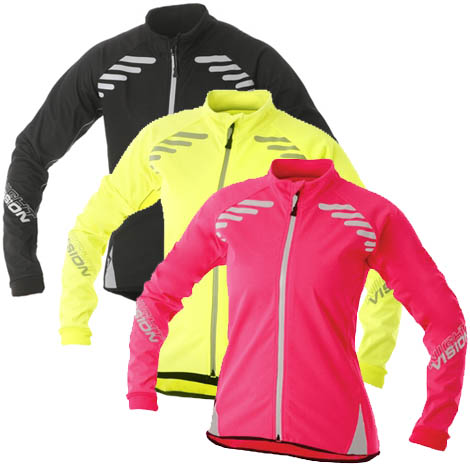
For the harsher climes of autumn and winter (and spring and usually summer too if you're cycling in Britain), you'll need a jacket. Women's
cycling jackets are always waterproof and usually windproof, but you'll have to shell out a little extra for the latter of those two. Like all women's cycle clothing which has been designed around the torso, cycle jackets are tailored to suit your body, and usually have an elasticated waistline to prevent the jacket riding up your back when you're riding your bike.
Lady's cycling jackets also usually have adj
ustable seals around the wrists and neck to keep rain out, and a clever ventilation system to keep your body temperature down. This is actually pretty important, since if you're working hard on your bike, you're going to build up quite a bit of moisture inside your jacket. Some well-placed vents, under the arms or down the bike for example, will keep this moisture down and keep you dry.
Lady's Cycling Jerseys
Like the jackets above, women's cycling jerseys are aimed at damper, colder cycling. However, they're generally a little thinner than jackets, and are designed to be worn over a base layer or on their own. It's good to have one of these in your wardrobe. They really are ideal for cycling, and they're usually constructed of high-tech, breathable fabrics in bright, high-visibility colours.
Body Suits
For women who take their cycling seriously, I mean seriously seriously, there are now a few cycling-specific women's body suits available. Usually made of padded Lycra, these body suits are precisely designed to give your cycling an aerodynamic edge. They also move the moisture away from your skin and allow your body to breathe. They're predominantly directed towards indoor cycling competitions and time-trials, but can just as easily be worn for road cycling and they're even pretty handy to use as an all-in-one base layer, perhaps with shorts and a jersey over the top.
Cycling Shorts for Women
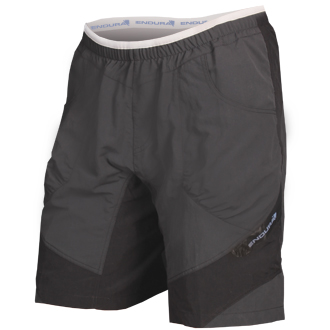
Choosing a pair of cycling shorts throws up few questions. First, where are you riding? If you're throwing your mountain bike down the side of a Welsh valley, or into an overgrown forest ravine, you'll probably want a baggy pair of cycling shorts. The baggier styles will have a spandex or Lycra lining with a chamois or synthetic chamois padding for better comfort and hygiene, and are manufactured by all the leading manufacturers, from Altura to Northwave and all brands in-between and beyond.
One advantage of baggier shorts is that they have pockets. This is probably just a small aspect of the overall choice, but I'm sure you can appreciate just how much hassle hip-pockets save relative to a back pack, which will have you taking it off and putting it back on, and digging around for your wallet and your keys.
However, if you're commuting to work, sticking to the roads and pavements all the way, then you may prefer Lycra or spandex cycling shorts. These are designed specifically to reduce drag in the air to give you that extra few miles per hour. We'll discuss Lycra cycling shorts with a bit more detail in a moment…
The next question concerns the weather, as all subjects relating to cycling seem to do. Obviously, shorts are generally better in warmer, dryer conditions, so we'll take that as read and be a bit more specific, by considering some more realistic situations. How about when it's nice and warm, but raining quite heavily? Well, the baggier shorts that we mentioned do tend to be waterproof, just as Lycra does, but baggier shorts can get heavy when they're wet and will rub annoyingly as they dry. Wet shorts are not good. Since water is such a good conductor of heat, wet clothing will quickly sap all of your body heat leaving you feeling fatigued and weak.
However, for really hot, sunny weather, big, baggy shorts are almost certainly preferable, allowing cool, clean air to circulate inside them to keep you cool. These baggy, summer shorts are as fashionable off the bike too, which means you won't necessarily have to get changed when you reach your destination. They're a little more casual, and will complement a more relaxed rider more than a more serious rider who has aerodynamics and drag coefficients on their mind.
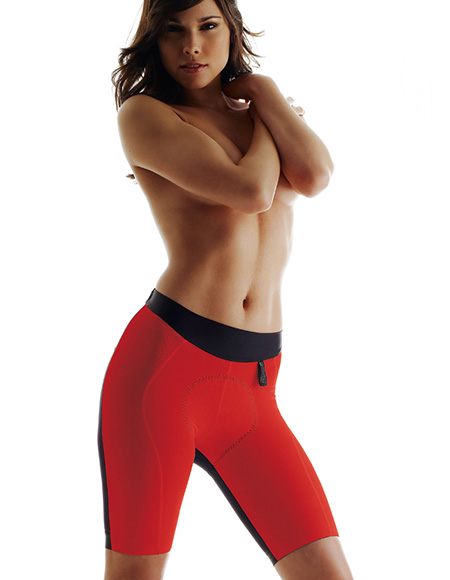
Lycra Cycling Shorts for Women
Next, are you comfortable wearing Lycra? It's not an unusual question really: there are thousands of people who wouldn't want to be seen dead in Lycra. It's not really… well… forgiving, is it? It has some extraordinary benefits for those that can pull it off, but those people tend to be fantastic cyclists already. Because they are experienced cyclists, we can learn from them. Lycra is comfortable, and it compresses the legs which staves off muscle fatigue that little bit longer. Furthermore, Lycra cycling shorts draw sweat away from your skin and the evaporation from the sweat helps to cool you down. Clever, eh? And if that wasn't enough, Lycra cycling shorts significantly reduce rubbing and friction, so rashes and blisters are virtually neutralised.
And you can always chuck a netball skirt or baggier shorts over the top if the visual intimacy of Lycra is not to your taste. Which brings us on to…
Lady's Base Layers
'Layers, layers, layers…' I'm sure that if you've learned anything from this guide so far, it's that layers are important and you can create layering from virtually any garment. But to do it properly you should start with a base layer and build up over it, so that a private micro-climate is generated between the layers that will work to keep you cool and dry. Base layers designed specifically for women include undershorts, singlets and base jerseys.
Cycling Undershorts
For your legs, your base layer should be a comfortable pair of undershorts. If you're wearing Lycra, this won't be necessary since Lycra is designed to be worn in its own, in direct contact with the skin. Women's cycling undershorts are made of soft, cotton-feeling fabrics that are designed to stretch and support your skin throughout the rigours of bike-riding and to provide breathable, fast wicking comfort ('wicking' refers to the movement of moisture within a fabric).
Women's Singlets & Base Jerseys
A singlet is a great base layer for your torso in the warmer months. Sleeveless and airy, and with real femininity in their designs, ladies' cycling singlets are ideal to wear under a T-shirt or jersey, with the option that they can be worn on their own as a top in their own right.
This same principle applies to women's base jerseys, which are generally very light due to their polyester construction. Like the jackets and cycling jerseys mentioned above, the base jerseys often have a slightly dropped tail to prevent them from riding up your back as you are cycling.
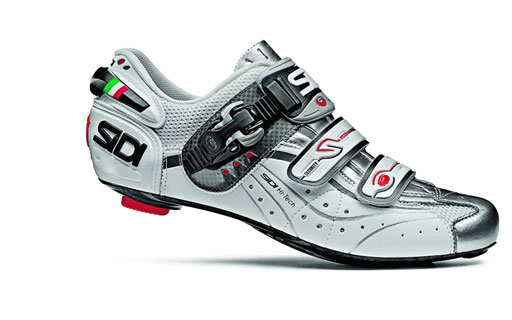
Women's Cycling Shoes
There are so many styles and types of ladies' cycling shoes to choose from, and the right choice is so important, that we should probably examine the different types of shoe with reference to the style of bike riding for which they were designed, and how they are organised on this site. First, let's talk about…
Women's Road Riding Shoes
These shoes are generally for sport or competition, and as such do not compromise on their functionality. At the lower end of the price of the road riding shoe price spectrum, you'll find shoes that have almost entirely plastic soles designed to deliver the most power possible directly onto the pedal. Toward the higher end, the soles are made of carbon fiber. Basically, they're stiff, and they're not really designed to be walked on: they have virtually no tread, so they're a little dodgy on wet or slippery surfaces, and you can actually damage them by walking long distances in them. They differ from men's road riding shoes in their slimmer heels which have been fabricated specifically to fit female feet. The next kinds of cycling shoes are…
Ladies' Mountain Bike Shoes
Similar to the road shoes we just discussed, mountain bike shoes are available for every level of cyclist, from leisure rider, through daily commuter, to competition level. However, they differ from women's road shoes in their flexibility. Women's mountain bike shoes are designed to be a great walking shoe and a great riding shoe, without compromising the quality of either aspect. It takes some pretty high-tech stuff to find this balance (with which I won't bore you here, if you're interested then check out the info on the mountain bike shoe page). Needless to say, the price goes up parallel with the quality, which is in turn parallel with the performance of the shoe.

